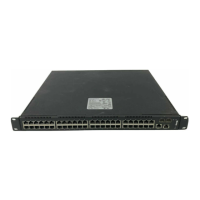Layer 2,3,IPv6+QoS Switch
_____________________________________________________________________________
Layer 2,3,IPv6+QoS Network Switch User Manual Version 0.1 Page: 798/970
Non-Configurable Data
IP Address - The IP address of the interface.
Subnet Mask - The subnet/network mask, that indicates the portion of the IP interface
address that identifies the attached network.
LSA Ack Interval - The number of seconds between LSA Acknowledgment packet
transmissions, which must be less than the Retransmit Interval.
OSPF Interface Type - The OSPF interface type, which will always be broadcast.
State - The current state of the selected router interface. One of:
Down - This is the initial interface state. In this state, the lower-level protocols have
indicated that the interface is unusable. In this state, interface parameters will be set
to their initial values. All interface timers will be disabled, and there will be no
adjacencies associated with the interface.
Loopback - In this state, the router's interface to the network is looped back either in
hardware or software. The interface is unavailable for regular data traffic. However, it
may still be desirable to gain information on the quality of this interface, either through
sending ICMP pings to the interface or through something like a bit error test. For this
reason, IP packets may still be addressed to an interface in Loopback state. To
facilitate this, such interfaces are advertised in router- LSAs as single host routes,
whose destination is the IP interface address.
Waiting - The router is trying to determine the identity of the (Backup) Designated
Router for the network by monitoring received Hello Packets. The router is not
allowed to elect a Backup Designated Router or a Designated Router until it
transitions out of Waiting state. This prevents unnecessary changes of (Backup)
Designated Router.
Designated Router - This router is itself the Designated Router on the attached
network. Adjacencies are established to all other routers attached to the network. The
router must also originate a network-LSA for the network node. The network- LSA will
contain links to all routers (including the Designated Router itself) attached to the
network.
Backup Designated Router - This router is itself the Backup Designated Router on
the attached network. It will be promoted to Designated Router if the present
Designated Router fails. The router establishes adjacencies to all other routers
attached to the network. The Backup Designated Router performs slightly different
functions during the Flooding Procedure, as compared to the Designated Router.
Other Designated Router - The interface is connected to a broadcast or NBMA
network on which other routers have been selected to be the Designated Router and
Backup Designated Router either. The router attempts to form adjacencies to both the
Designated Router and the Backup Designated Router.
The State is only displayed if the OSPF admin mode is enabled.
Designated Router - The identity of the Designated Router for this network, in the view
of the advertising router. The Designated Router is identified here by its router ID. The
value 0.0.0.0 means that there is no Designated Router. This field is only displayed if the
OSPF admin mode is enabled.

